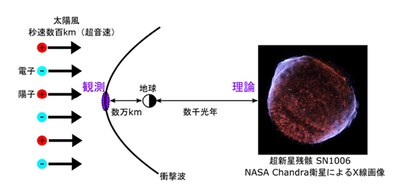
Stochastic shock drift acceleration: plausible solution to the long-standing electron injection problem
The University of Tokyo, Chiba University, the Institute of Space and Astronautical Science (ISAS) of the Japan Aerospace Exploration Agency (JAXA), and Osaka University have presented a plausible solution to mechanisms for the origin of high-energy cosmic ray electrons.
Cosmic ray acceleration in supernova remnant shocks can be explained by the “first-order Fermi acceleration of electrons,” in which particles gain non-thermal energies in astrophysical shock waves; however, the origin of these non-thermal particles is unknown. This is called the "problem of electron injection" and has remained unresolved.
It is believed that young supernova remnant (SNR) shocks are efficient acceleration sites of cosmic-ray electrons and that the diffusive shock acceleration (DSA) process is responsible for the acceleration of cosmic-ray electrons.
Using data of Earth’s bow shock from NASA’s four-spacecraft Magnetospheric Multiscale (MMS) mission, this group verified their stochastic shock drift acceleration (SSDA) theory for the injection. The SSDA theory introduces stochastic pitch-angle scattering of electrons, which diffusively confine the particles within the acceleration region longer than in the absence of scattering.
The researchers focused on a period during which the energetic electron flux was enhanced in the bow shock, the boundary at which the speed of the stellar wind abruptly drops as a result of its approach to the magnetopause.
They investigated the propagation characteristics of whistler mode waves statistically for clarifying the electron scattering efficiency in the Earth’s bow shock transition layer using the data from MMS spacecraft. Whistler mode waves, high frequency electromagnetic waves observed in the shock transition layer, are thought to scatter electrons efficiently by cyclotron resonance.
In situ measurements of the Earth’s bow shock by the MMS mission provided direct evidence for SSDA: (a) phase space density of electrons, (b) first-order pitch-angle anisotropy of electrons, and (c) frequency-time spectrogram of magnetic field fluctuations.
Recent three-dimensional ab initio modeling of collisionless shocks as well as in situ measurements by MMS found pitch-angle scattering. The generation of high-frequency whistler waves is probably related to the pitch-angle anisotropy. SSDA may accelerate subrelativistic electrons because of intense whistler waves in the transition layer, and may potentially provide a seed population for DSA. This group confirmed the appearance of intense high-frequency and coherent whistler waves which can scatter low-energy electrons via cyclotron resonance.
SSDA can explain electron acceleration to mildly relativistic energies at high-speed astrophysical shocks, which may provide a solution to the long-standing issue of electron injection.

Figure 1

Figure 2
The article, “Observational Evidence for Stochastic Shock Drift Acceleration of Electrons at the Earth’s Bow Shock,” was published in Physucal Review Letters at DOI: https://journals.aps.org/prl/abstract/10.1103/PhysRevLett.124.065101
